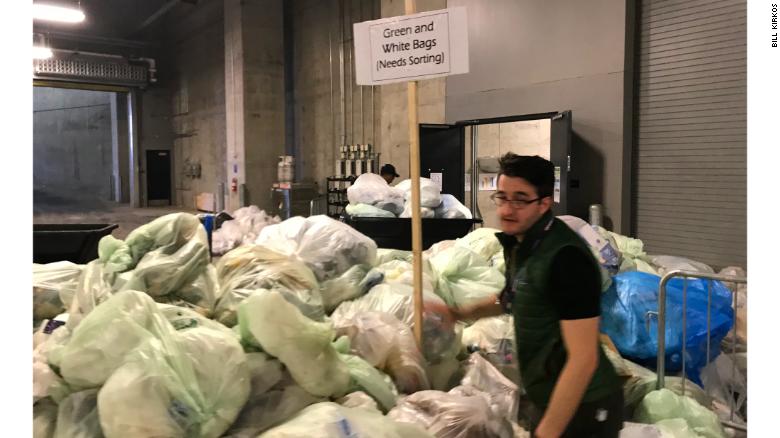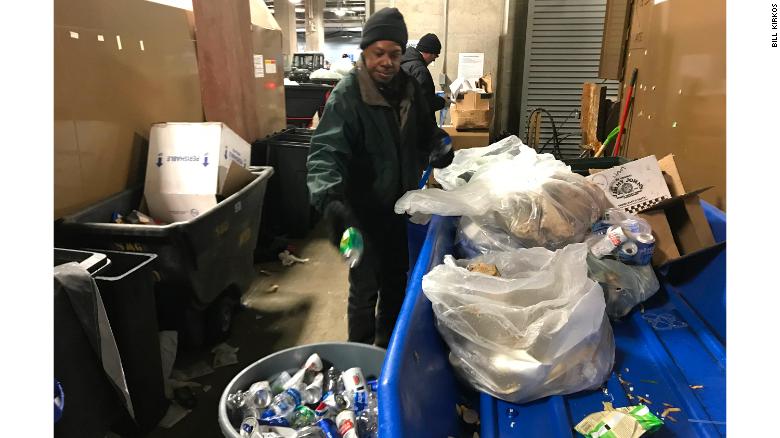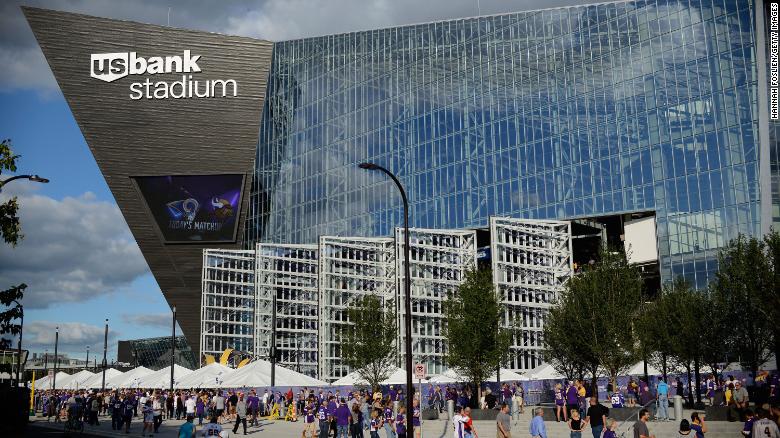https://edition.cnn.com/2018/02/06/us/super-bowl-zero-waste/index.html
How this year's Super Bowl stadium managed to dramatically reduce waste
By Bill Kirkos, CNN
Updated 1828 GMT (0228 HKT) February 6, 2018
Minneapolis (CNN)After the Eagles and Patriots squared off in Super Bowl LII, another battle got started inside US Bank Stadium.
On Monday, hundreds of stadium employees, food vendors, sustainability experts and volunteers worked together to sort about 60 tons of waste, marking it to be recycled, composted or reused.
The stadium had set a goal for itself to put on a "Zero Waste" Super Bowl -- meaning that 90% of all waste generated on Super Bowl Sunday stays out of landfills. The remaining 10% will be sent to a waste-to-energy incineration plant where it will be burned to create electricity.
Sponsor Content
What two leading HPV researchers want you to know about the link between HPV and cancer
Dr. Silvia de Sanjose and Dr. Xavier Bosch have dedicated their lives to HPV cancer research.Now they're sharing their story to educate others.
Content provided by MSD
Bradley Vogel, the stadium's sustainability coordinator, stood over a small mountain of trash bags filled with empty beer cups and cheese-stained nacho trays, and placed a sign in the middle designating it ready for sorting. The average Vikings game generates about 40 tons of waste, he said, but the Super Bowl brings in more sales and more trash.
"This is my dream job," he said as he supervised a team of 10 sorters sifting through the garbage bags.

US Bank Stadium Sustainability Coordinator Bradley Vogel places a sign in the middle of a pile of trash bags for sorting on Monday. Green bags were for composting and white bags for waste.
"I'm very confident we will at least get very close to 90%," said Vogel, though it will be a few days before the sorting is finished and they'll know for certain how close the stadium came to meeting its goal.
Vogel is one of the people leading the push to make US Bank Stadium the first permanent "Zero Waste" stadium in the NFL. He says other stadiums may claim to be "Zero Waste" but are not, because they send more than 10% of their waste for incineration.
The NFL says it's a big priority to hold more "Zero Waste" Super Bowls in the future, and for the stadiums to commit to implementing "Zero Waste" policies in the long term. But the infrastructure at the host stadium is key.
"Most stadiums won't try and do this when they're first built," Vogel said. "They just want to get the operations down... they want to make sure they get the food out before they worry about what happens on the back end."

Workers sort waste at US Bank Stadium.
The 2015 Super Bowl in Phoenix succeeded in diverting 90% of its waste from landfills, but didn't manage to maintain that standard after the day itself, NFL environmental director Jack Groh says.
The needed infrastructure wasn't in place to properly turn food waste, cups and those grease-stained pizza boxes into compost, which can then be used in fertilizing soil.
"Each year we kind of start with an empty slate and look at each community," he said.
In Atlanta, which will host next year's Super Bowl, there isn't a commercial composting facility within a reasonable distance of the stadium, Groh said.
Minneapolis is already known for having stronger sustainability programs than many other large cities, but the Minnesota Pollution Control Agency, Hennepin County and the city all supported and pushed for the effort, Vogel said. "Since (the stadium) is partly publicly funded, they wanted it to be sustainable."
About 50,000 thousand Minneapolis homes participate in a composting program, according to the Hennepin Recovery Energy Center. "That's probably better than most other (similar-sized) US cities," says Dave Newport, director of the Environmental Center at the University of Colorado at Boulder.
"All our other stadiums in Minneapolis are super sustainable," Vogel said. "Target Field, where the Twins play, has a monthly diversion rate of around 70%."

US Bank Stadium in Minneapolis is aiming to become the first permanent "Zero Waste" NFL stadium.
"This is a whole new level for us and the stadium," Groh said.
Back in September, US Bank Stadium was only diverting about 24% of its waste, Vogel said. Increasing the waste diversion rate in such a short period of time isn't always easy. Convincing Aramark to spend more money on compostable cups and food items was a huge part of the process. Getting the food vendor and Pepsi on board was also key to the putting the plan into place.
Vogel is convinced that going "Zero Waste" will save money in the long run. "A lot of our start-up costs are one-time purchases, like our organics compactor." He says the reduction in trash hauling payments will eventually cut the stadium's costs by as much as half.
Of equal importance will be continuing to educate and convince the public. Pepsico brought in hundreds of volunteers, some of them paid, to monitor every waste, recycling and composting bin in the entire stadium during the Super Bowl to help fans find the right bins to throw away their trash.
One of those volunteers, Steven Whiting, came with about a dozen other students from the University of Louisville. "Being part of trying to make this stadium realize 90% waste diversion is pretty exciting," he said.
Getting enough of the general public excited about it will also be a factor in whether fans will help permanently make the stadium a "Zero Waste" facility.

沒有留言:
張貼留言